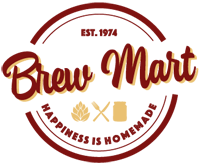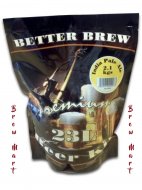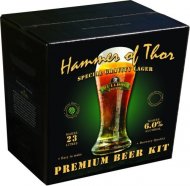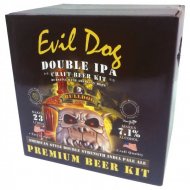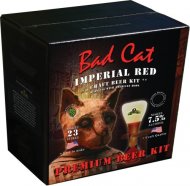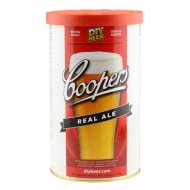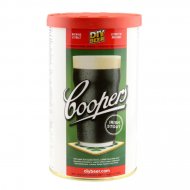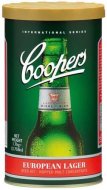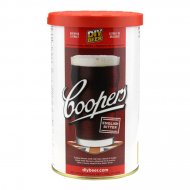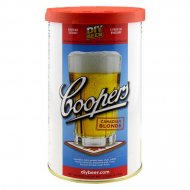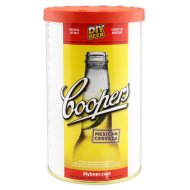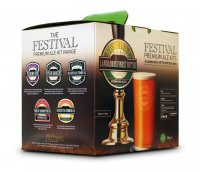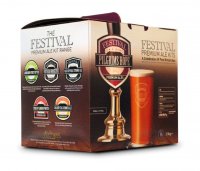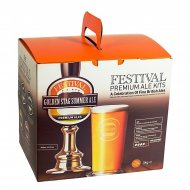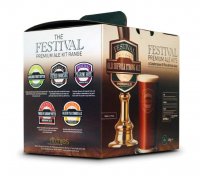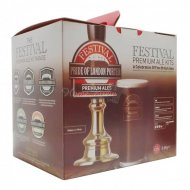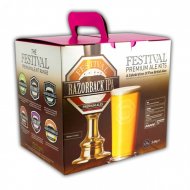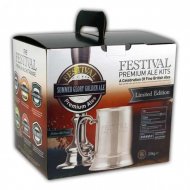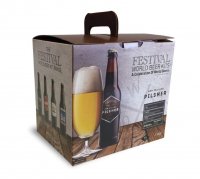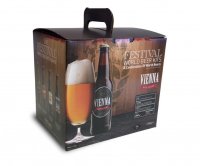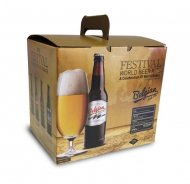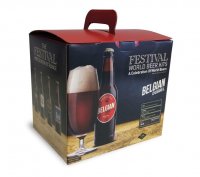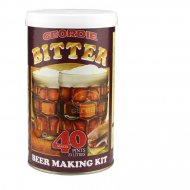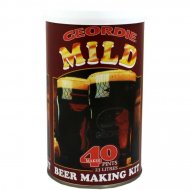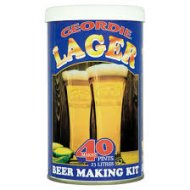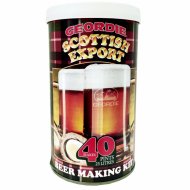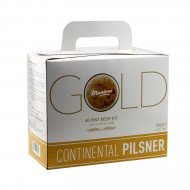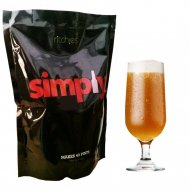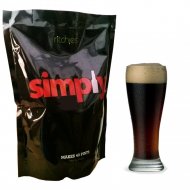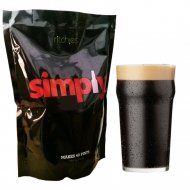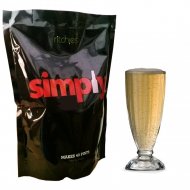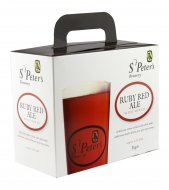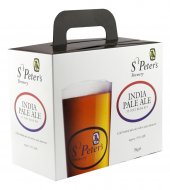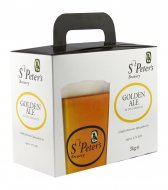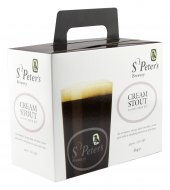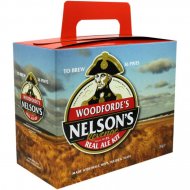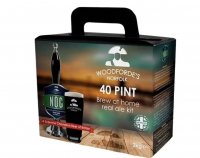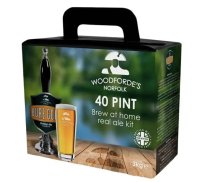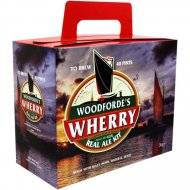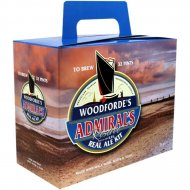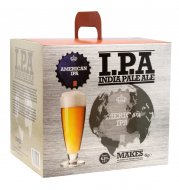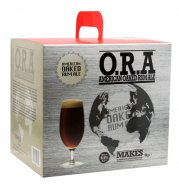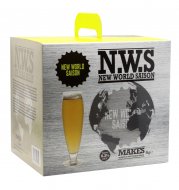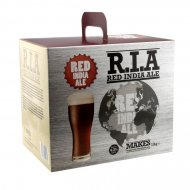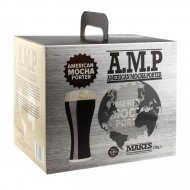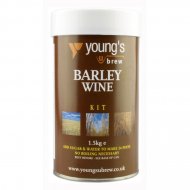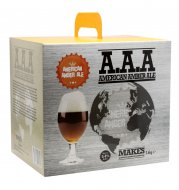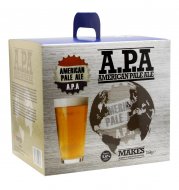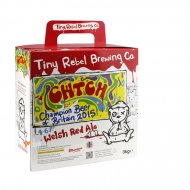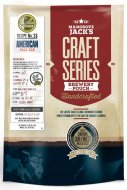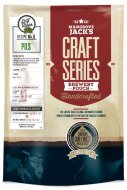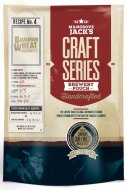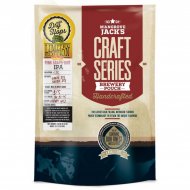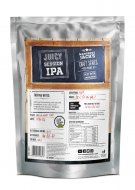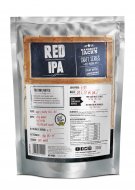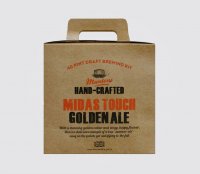Sign up to the Brew Mart newsletter for the latest news, offers & more
Please note that Brew Mart will be closed on Saturday, 5th July, AND Saturday, 12th July. Thank you.

Homebrew Beer Kits
Brew Mart has all the varieties of home brew beermaking kits you will need to brew your beer in the comfort of your own home.
You can use a home brew beer making kit to make forty pints of high-quality beer, or you can brew your own beer kit from scratch using hops and grains.
Bulldog Brews Evil Dog American Double Strength IPA Home Brew Kit - 40 pt.
Home Brew Beer Making Kits.
Brew Mart has a great range of malt extract beer kits to suit all budgets. These are so easy to brew and only need water and, in some cases, brewing sugar to be added.
Beer kits offer pub-quality beer, making up to 40 pints, ready within 3-4 weeks.
For 40 pints you will need approx 45 x 500ml beer bottles or 30 x 750ml beer bottles
F.A.Q.
What comes in a beermaking kit?
Ingredients Found In A Beermaking Kit
- Malt Extract. Malt extract is used instead of grain. The malt extract is either dry or a syrupy liquid and is the base for the beer.
- Yeast. Yeast is available with each of the extract recipe kits.
- Hops. Often a liquid extract is added to the malt during production. Occasionally hop pellets are supplied for dry hopping.
Is it worth brewing your own beer?
There is a wide range of homebrew beer making kits ranging from the basic to award-winning beers like Cwtch or Woodfordes Wherry.
Most of the argument of "How good is a beer making kit?" comes down to personal preference. At Brew Mart, we do not sell kits that do not meet our high standards. Basic beer kits are a great learning tool for new homebrewers because the kit provides an excellent solid base product that is pleasant and unfussy. This characteristic also allows more adventurous homebrewers to play around with adding extra hops and malts or different yeasts to learn how they can affect the brew's flavour, colour, and aroma. By following the instructions, you will produce a good beer. However, if you do some research and slightly modify the instructions to your liking, you could make GREAT beer from a basic kit.
The higher quality homebrew beer kits have significantly improved over the years. The latest ranges of quality kits showcase what is achievable in homebrew. The end product from these kits is often regarded as superior to many commercially available beers, and you have the added reassurance of knowing what has gone into your beer.
How do beer kits work?
The beer kits contain a concentrated hopped liquid malt extract, to which you add water to produce a wort (the name for a pre-fermented beer).
You then add yeast which ferments over a few days, turning the sugar into alcohol.
The fermented liquid (beer) is then stored in a barrel or bottles and cleared before drinking.
WHAT IS BEER?
Introduction
You have decided to make yourself some beer.
Getting into a hobby like brewing can be daunting at first, but it needn't be.
The most straightforward way to start is to purchase a homebrew beer starter kit containing all the essential equipment needed to brew your first beer kit.
Brewing a beer kit is most brewers first step into making beer.
Most will enjoy the brewing process and, depending on the finished product's outcome, many will continue to pursue their new hobby.
Brewing beer doesn't have to be so challenging. With a bit of know-how, you can make sure every beer you brew is a winner.
What Is Beer
To answer this, we need to start with the basics.
Beer Ingredients
All beers consist of four essential ingredients; Water, Barley, Yeast and Hops.
Some may have more ingredients, but the vast majority of beers you buy at the shops only contain these four key ingredients.
These ingredients combine and ferment to produce alcohol which in turn creates a beer.
- Barley is a grain, just like wheat. Before reaching the brewery, barley is processed via malting, enabling the brewer to extract the stored sugars.
- Malting the barley allows the enzymes present in the barley to change the starch into sugars. These sugars are what the yeast feeds on and converts to alcohol. When fermenting from malts, flavour characteristics from the malt are maintained, enabling us to make beer.
- Hops are the flowers of the hop vines. The flowers are full of acids and resins with many different aromas and flavour profiles. However, the main one is bitterness, which is used to balance the sweetness of the malt. You can also add them later in the process to season the beer. This stage is where the subtler and more complex flavours become apparent.
- Brewing Yeast is the organism that turns the sweet liquid created from the grains into the beer itself. Yeast consumes the sugars and, as a by-product, produce alcohol and carbon dioxide, which are vital components of beer.
- Water is the beer's main ingredient, and any water good enough to drink will be just fine for use with your homebrew beer kit.
A beer making kit has all the essential ingredients you need to make your first beer.
Beer kits are produced to make it easy to go from a kit to beer in just a few quick and easy steps.
The next stage is choosing a beer kit. To do this, we need to look at the different beer kits available and choose one to suit your needs.
TYPES OF BEER KIT
What Ale Kit to Choose?
If you have not already purchased a beer kit, your first decision is to select one.
There is a large array of beer kits from which to choose.
Here we will look at some of the more popular types of beer kits to help you make an informed decision when you make your purchase.
Basic Kits
The simplest and cheapest beer kits on the market consist of just two things. A sachet of yeast and a single container of hopped malt extract.
The attraction of budget kits is mainly the price. Plus, the method of brewing the beer is usually the simplest. The budget kits have the fewest steps to creating your beer. However, many use them as a base for more adventurous recipes.
However, there are some drawbacks. Most people realise the less you pay, the less refined the product is. High-quality kits are extensively developed to provide a well-balanced beer full of flavour and character. Cheaper kits are much less researched and kept very basic. Hence their suitability for experimentation. When brewed, the beer will be good. However, it will not be as refined as a more expensive beer kit.
These kits have less malt than more expensive kits. The less malt means they require additional brewing sugar to produce the content of alcohol needed. Using brewing sugar in the brewing process is standard. It allows the brewer to increase the alcohol content without increasing the body or unbalancing the flavour. Adding sugar may be desirable in certain circumstances, but the more the malt is substituted for sugar, The more significant the loss of body and flavour.
Excellent beer is straightforward to make with these budget style kits, and many brewers are very happy using these beer kits. To get you started, Brew Mart has listed below a selection of the more popular of these budget beer kits.
Geordie - Bitter & Mild
Harvest - Bitter & Barley Wine
Brew Maker - Shamrock Velvet, Victorian Bitter & Scottish Heavy
Better Brew - India Pale Ale (I.P.A.)
Simply - Bitter, Yorkshire Bitter, Export Stout, Pale Ale, Mild, Brown Ale and Ginger Beer.
Mid Range Kits
As the name suggests, mid-range kits are in between the basic kits and the premium kits. Typically, they contain between 1.7 and 2.1 kilos of malt, which is more than most budget kits. Also, a significant amount of additional research and development has gone into refining the product. Mid-range kits still need sugar to boost the alcohol content. However, because of the more delicate balance of flavours, they are not quite as suitable for adaptation and experimentation.
Cooper's- European Lager, Real Ale, Canadian Blonde, Mexican Cerveza, English Bitter.
Mangrove Jack's - Pils, Juicy I.P.A., American I.P.A., Hellas Lager, Bavarian Wheat, Pink Grapefruit I.P.A. and many more…
All Malt Extract Kits
Moving further up the price range, you have all malt extract kits. These homebrew beer kits contain 3 kilos of malt rather than1.5 kilos like the budget kits discussed previously.
All malt extract kits mean there is no need for any additional sugar.
Due to this, the beer has more body and flavour and is of better quality. These kits do not require any boiling, so there is no need for additional equipment here either.
A few of these two can beer kits come with hop sachets to add to the beer during fermenting, and this adds extra hop aroma and character to the finished product. These minor additions add more character to the beer than the basic versions mentioned previously.
MAKING THE BEER KIT
Putting Your Beer Kit Together
All homebrew kits will come with instructions. Each beer kit will be slightly different. Consequestly it is important to read the instructions before starting to brew.
Beer kits range in value. Generally, the more you are prepared to pay, the better the final product.
Basic Steps
Here is a list of the basic steps that come with most beer kits to give you an idea of what's involved.
- Clean and sanitise all your equipment. Be sure to buy some steriliser along with the beer kit.
- Mix the malt extract with an amount of water specified in the instructions. The beer kit will usually have one or two tins of concentrated malt extract, which means that mixing with water dilutes them to the correct level for your beer.
- Mix everything up by stirring and then add the yeast. Adding yeast is called pitching, and yeast is the organism that converts the malty liquid (wort) into beer by creating carbon dioxide and alcohol.
- Fermentation is an essential element of the brewing process. It is often not explained very well with your beer kit instructions so let see what's happening during this process.
Yeast and Fermentation
Fermentation is the stage of the brewing process which is the slowest and requires the most patience. Fermentation is where the brewer does nothing, but the yeast converts the sugars into alcohol and carbon dioxide.
Yeasts are specific strains of fungus that have developed to be particularly useful to the brewer. They are ideally suited to the environment created by the beer kit and has all the food (sugar) and nutrients which they need to multiply and reproduce. Adding yeast is essential because, without yeast, we wouldn't have any alcohol at all. Yeast also provides a large proportion of flavour to the beer, so making sure the yeast is happy is vital for it to perform as well as possible.
Once you have pitched the yeast into your fermenting bin containing the sweet malty liquid, they begin reproducing and multiplying.
As the yeast multiplies, it consumes the sugar, and the by-product of this is producing alcohol. The more sugar available to the yeast, the higher the alcohol content of the beer. The amount of sugar available to the yeast is how brewers can control the alcoholic range of their beers.
The perfect climate requires keeping the fermenter bucket at a constant temperature, ideally between 17°C – 22°C.
If the beer becomes too hot, the yeast will gradually die and leave you with unfermented beer. If the solution is cold, the yeast will not work but hibernate and won't ferment the beer again. Keep yeasts around room temperature, and you will have a great beer to enjoy.
Click here to read How to brew beer
10 Benefits of a beermaking kit
1 The number one benefit is saving money.
The price of a 5-gallon home brew starter kit and home brew beer kit may seem a bit much upfront, but it will save you money in the long run as you can use the equipment repeatedly.
2 You will become good at beer brewing
Anyone who has a home brew system can make a fantastic beer. It isn't difficult. All you have to do is to be able to read and follow directions. You can make beer as straightforward or as complex as you'd like. However, the most crucial aspect is that you observe great cleaning habits, follow measurements well and look after your yeast. Your home brewed beer should then turn out great. A challenging aspect of brewing your beer is bottling. However, using the little bottler has simplified this task enormously, and it is straightforward to get the hang of it. Just remember, bottling will always be a bit time-consuming.
3 With a beer making kit - You can explore and experiment.
Brewing beer is always an experiment. You will be able to explore more avenues than commercial brewers would. If you've ever thought about what a specific ingredient would taste like in beer, now's your chance. Brewing is an adventure of practising until you have a spot-on beer that shows you have experimented with uncharted waters that left you with a beautiful and tasty brew.
4 A Home brew beer making kit is much better than you thought.
Did you know that you can purchase a home brew beer kit and the supplies you need online or in-person at Brew Marts retail shop? At Brew Mart, we have all of the brewing and starter equipment you could ever need. It is an excellent way for you to learn about brewing beer, and it's the perfect way to try your hand at a hobby to see if it's something you want to take part in for years to come.
5 Your appreciation for beer will grow as you gain more knowledge.
When you brew and bottle your beer, you'll soon grow and appreciate all the aspects of beer making. Learning the process and seeing what goes into making a great beer will excite you and encourage you to experiment more. You will appreciate great beer more because you'll know how much work and love went into getting a beer to taste that amazing.
6 Home brewed beer does make a great gift.
During holiday time and for special occasions, you can spend quite a bit of money on gifts for friends and family. Instead of splurging on presents your loved ones may only use a couple of times, give them something they'll love to try. A homemade gift is caring, and thoughtfulness, much more than any bought gift can attain. Believe us; people will love and be highly impressed with their present no matter the occasion.
7 Drinking beer in moderation may provide health benefits.
Drinking six beers a night may not be the healthiest idea, but beer drunk in moderation has health benefits. Beer contains fibre, antioxidants, fibre and vitamin B. Also, beer is one of the richest sources of silicon, something you can't find in many other alcoholic beverages. These are all ingredients that your body will absorb when you drink beer.
8 Enhance your pride and enjoyment.
If you've wanted to take up a hobby but haven't been sure where to start, purchase Brew Mart's home brew starter kit and home brew beer kit. Doing so, you will create beautiful experiences you will not forget. Also, you will learn a great deal about beer, the ingredients and the start of a process that will give you some satisfaction and pride.
9 Expand the fun with friends.
Drinking beer is always fun with friends. Think about doing that in your home or garden, drinking your own, home-brewed beer. It will be exciting and bring you and your friends closer together. Your friends will likely follow suit if you get adsorbed into brewing beer. You can develop a social group of beer brewing you never knew would exist. Like-minded hobbyists and a community that loves brewing beer, there's nothing more you could ask.
10 Take part in one of the oldest traditions.
Brewing beers is a 9,000-year-old tradition. That's correct; if you brew, you'll participate in an age-old practice that stretches back into the Neolithic age. Brewing beer began as an essential piece of daily life in the community and home, and it is still enjoyed and practised worldwide.
Peruse Brew Mart's Brewing Systems
Want to get started brewing a beer you never thought was possible? Join Brew Mart, a leading beer supply company. We offer advice, recipes, beer systems and all the supplies you need. We can provide insight and answer any questions you may have.
Brew Mart give you a complete choice of different types of beer, such as
Ale
American & New World beer kits
Click here to learn how to brew beer at home
A guide to brewing
